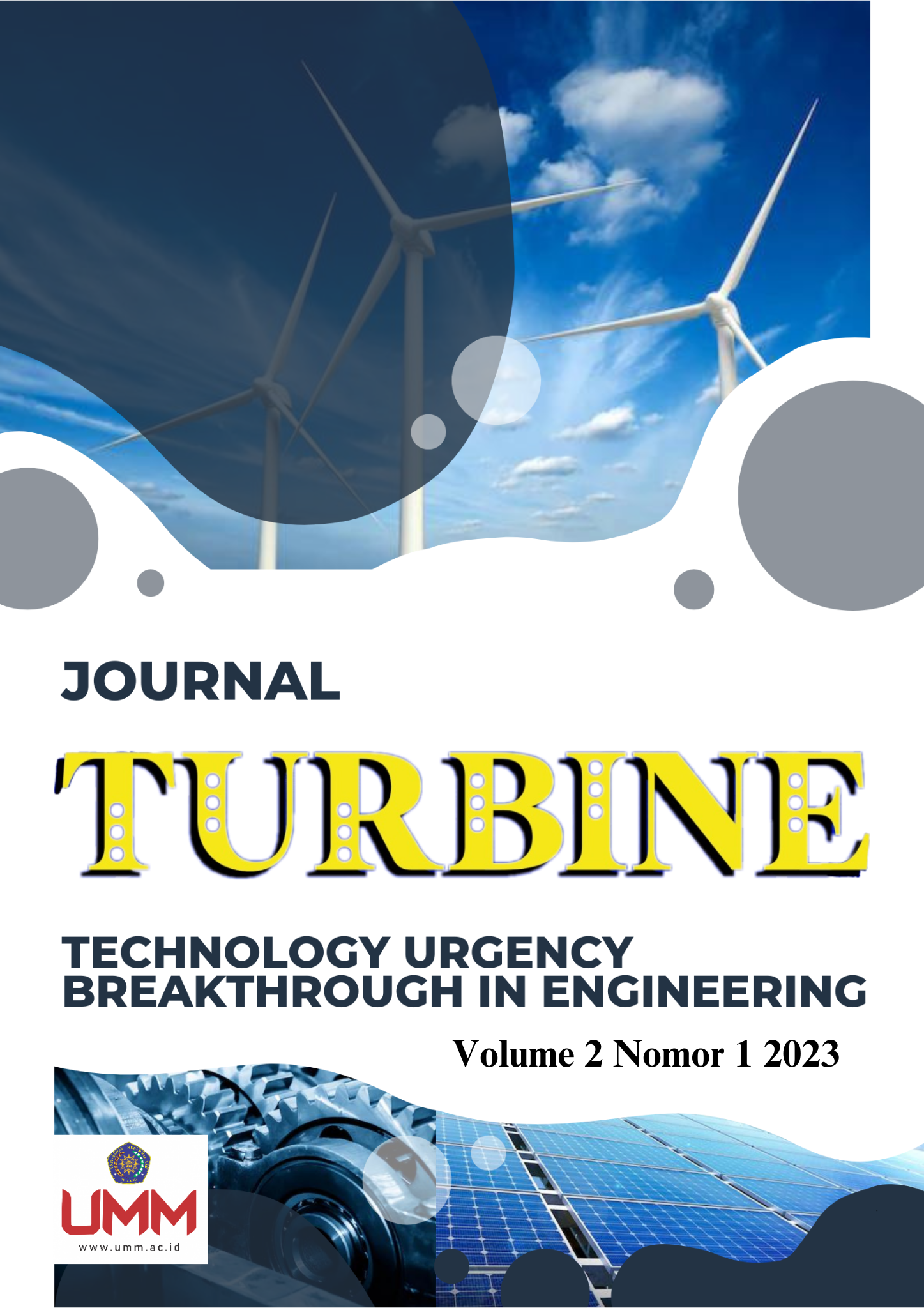ANN adalah metode analisis dima Prediksi Kekuatan Komposit Tandan Kosong Kelapa Sawit (TKKS) Dengan Menggunakan Artifical Neural Network Radial
Keywords:
Composite, Artificial Neural Network, Prediction, Artificial Neural Network , KompositAbstract
Industri kelapa sawit saat ini berkembang semakin pesat, sehingga menghasilkan limbah yang masih mempunyai nilai ekonomis tinggi untuk diolah menjadi material teknik. Seiring dengan adanya berbagai pengembangan inovasi dalam dunia material untuk pemanfaatan tandan kosong kelapa sawit yang dapat digunakan sebagai komposit untuk berbagai jenis material, akan tetapi sebelum memproduksi secara luas perlu adanya pengujian Tarik serta pengujian bending dari komposit tersebut. Artificial Neural Network (ANN) dapat membantu mengurangi waktu serta biaya yang diperlukan dalam pengujian komposit. Artificial Neural Network (ANN) atau jaringan saraf tiruan merupakan model komputasi yang terinspirasi dari system saraf manusia dalam memecahkan masalah. dimana peneliti and operasi di mendapatkan ilmu dari pengetahuan tentang sel saraf biologis didalam otak.Setelah dilakukan uji coba prediksi didapatkan bahwa nilai yang keluar mendekati data target yang dapat dijadikan acuan data prediksi, dan data grafik data prediksi menunjukan bahwa kemungkinan gagal kecil hanya sekitar 1,6181e-13 at epoch 83
Kata Kunci : Komposit, Artificial Neural Network (ANN), Prediksi
Downloads
References
J. C. Kurnia, S. V. Jangam, S. Akhtar, A. P. Sasmito, and A. S. Mujumdar, “Advances in biofuel production from oil palm and palm oil processing wastes: A review,” Biofuel Res. J., vol. 3, no. 1, pp. 332–346, 2016, doi: 10.18331/BRJ2016.3.1.3.
B. Sutrisno and A. Hidayat, “Pyrolysis of palm empty fruit bunch: Yields and analysis of bio-oil,” MATEC Web Conf., vol. 154, 2018, doi: 10.1051/matecconf/201815401036.
N. A. Latip, A. H. Sofian, M. F. Ali, S. N. Ismail, and D. M. N. D. Idris, “Structural and morphological studies on alkaline pre-treatment of oil palm empty fruit bunch (OPEFB) fiber for composite production,” Mater. Today Proc., vol. 17, pp. 1105–1111, 2019, doi: 10.1016/j.matpr.2019.06.529.
N. Saba, M. Jawaid, and M. T. H. Sultan, An overview of mechanical and physical testing of composite materials. Elsevier Ltd, 2018. doi: 10.1016/B978-0-08-102292-4.00001-1.
M. Buhrmester, T. Kwang, and S. D. Gosling, “Amazon’s mechanical Turk: A new source of inexpensive, yet high-quality, data?,” Perspect. Psychol. Sci., vol. 6, no. 1, pp. 3–5, 2011, doi: 10.1177/1745691610393980.
M. K. Kazi, F. Eljack, and E. Mahdi, “Optimal filler content for cotton fiber/PP composite based on mechanical properties using artificial neural network,” Compos. Struct., vol. 251, p. 112654, 2020, doi: 10.1016/j.compstruct.2020.112654.
S. A. Bello, J. O. Agunsoye, S. B. Hassan, M. G. Z. Kana, and I. A. Raheem, “Epoxy resin based composites, mechanical and tribological properties: A review,” Tribol. Ind., vol. 37, no. 4, pp. 500–524, 2015.
M. M. Lau and K. H. Lim, “Review of adaptive activation function in deep neural network,” 2018 IEEE EMBS Conf. Biomed. Eng. Sci. IECBES 2018 - Proc., no. 1, pp. 686–690, 2019, doi: 10.1109/IECBES.2018.08626714.
O. I. Abiodun, A. Jantan, A. E. Omolara, K. V. Dada, N. A. E. Mohamed, and H. Arshad, “State-of-the-art in artificial neural network applications: A survey,” Heliyon, vol. 4, no. 11, p. e00938, 2018, doi: 10.1016/j.heliyon.2018.e00938.
M. Zare, H. R. Pourghasemi, M. Vafakhah, and B. Pradhan, “Landslide susceptibility mapping at Vaz Watershed (Iran) using an artificial neural network model: A comparison between multilayer perceptron (MLP) and radial basic function (RBF) algorithms,” Arab. J. Geosci., vol. 6, no. 8, pp. 2873–2888, 2013, doi: 10.1007/s12517-012-0610-x.
Y. Zhou, Y. Wang, F. Ma, F. Ding, and T. Hayat, “Parameter estimation for a class of radial basis function-based nonlinear time-series models with moving average noises,” J. Franklin Inst., vol. 358, no. 4, pp. 2576–2595, 2021, doi: 10.1016/j.jfranklin.2021.01.020.
S. Patra, “Epigenetic Regulation and Aging Epigenetic Regulation and Aging,” no. October 2015, 2019, doi: 10.1038/ejcn.2014.173.4.
A. Zayegh and N. Al Bassam, “Neural Network Principles and Applications,” Digit. Syst., 2018, doi: 10.5772/intechopen.80416.
L. R. Beltrán S., “How neural machine translation works,” Mach. Transl. everyone Empower. users age Artif. Intell., pp. 141–164, 2022, doi: 10.5281/zenodo.6760020.
K. Irie and J. Schmidhuber, “Learning to Control Rapidly Changing Synaptic Connections: An Alternative Type of Memory in Sequence Processing Artificial Neural Networks,” pp. 1–8, 2022, [Online]. Available: http://arxiv.org/abs/2211.09440
M. Neuroscience, “Simulation of fronto-parietal neural population activity to probe dimensionality reduction methods . submitted by,” 2021.
H. Fang, Y. Zeng, J. Tang, Y. Wang, Y. Liang, and X. Liu, “Brain-inspired Graph Spiking Neural Networks for Commonsense Knowledge Representation and Reasoning,” pp. 1–24, 2022, [Online]. Available: http://arxiv.org/abs/2207.05561
P. Celard, E. L. Iglesias, J. M. Sorribes-Fdez, R. Romero, A. S. Vieira, and L. Borrajo, A survey on deep learning applied to medical images: from simple artificial neural networks to generative models, vol. 35, no. 3. Springer London, 2023. doi: 10.1007/s00521-022-07953-4.
F. P. V. Ferreira, R. Shamass, V. Limbachiya, K. D. Tsavdaridis, and C. H. Martins, “Lateral–torsional buckling resistance prediction model for steel cellular beams generated by Artificial Neural Networks (ANN),” Thin-Walled Struct., vol. 170, no. October 2021, 2022, doi: 10.1016/j.tws.2021.108592.
Q. Zhang, A. R. Abdullah, C. W. Chong, and M. H. Ali, “A Study on Regional GDP Forecasting Analysis Based on Radial Basis Function Neural Network with Genetic Algorithm (RBFNN-GA) for Shandong Economy,” Comput. Intell. Neurosci., vol. 2022, 2022, doi: 10.1155/2022/8235308.
Downloads
Published
Issue
Section
License
Copyright (c) 2023 Bayu Mufaqih Bayu, Agus Mujianto, Hery Triwaloyo

This work is licensed under a Creative Commons Attribution-NonCommercial 4.0 International License.




